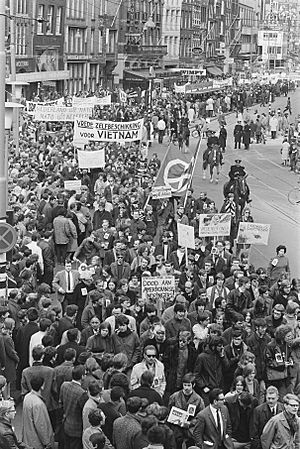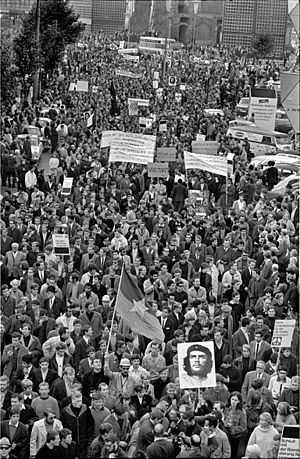List of protests against the Vietnam War facts for kids
The Vietnam War was a long and difficult conflict that took place from the 1950s to the 1970s. Many people around the world, especially in the United States, did not agree with the war. They believed it was wrong for the U.S. to be involved. These feelings led to many protests, which were a big part of the 1960s and 1970s. People used different ways to show their disagreement, like marching, holding vigils, and speaking out.
Contents
Why Did People Protest the Vietnam War?
The protests against the Vietnam War started early, even before the main fighting began. Many people felt that the U.S. should not interfere in Vietnam's affairs. They were worried about the violence and the loss of life.
Early Concerns About U.S. Involvement
- In 1945, some American sailors spoke out. They were upset that U.S. ships were used to transport European troops. These troops were going to Vietnam to control the local people.
- By 1954, a group called the American Friends Service Committee (Quakers) used newspapers to share their worries. They feared the U.S. would get involved in Vietnam as France left.
Growing Protests in the 1960s
As the U.S. sent more soldiers to Vietnam, protests grew larger.
- In 1960, 1,100 Quakers held a silent protest around the Pentagon.
- By 1963, protests were happening in other countries like England and Australia.
- The War Resisters League organized the first U.S. protest against the war in New York City. They also spoke out against how the U.S.-supported South Vietnamese government treated Buddhists.
Key Moments in the Anti-War Movement
The anti-war movement gained strength through many important events and actions.
Students and Draft Resistance
- In 1964, students at Yale University planned big demonstrations.
- On May 2, 1964, hundreds of students marched in New York City and San Francisco. Smaller protests also happened in other cities.
- Some young men publicly burned their draft cards to protest the war. This was a powerful act of resistance.
- The Free Speech Movement at the University of California, Berkeley helped students organize political events on campus.
- In December 1964, protests happened all over the U.S. in many cities, bringing together thousands of people.
Major Demonstrations and Teach-Ins
- In 1965, "teach-ins" became popular at universities. These were discussions and lectures about the war. The first big one was at the University of Michigan, with 3,000 students attending.
- The Students for a Democratic Society (SDS) organized a large march in Washington, D.C. in April 1965. Between 15,000 and 20,000 people attended.
- The Vietnam Day Committee in Berkeley, California, organized a huge protest of 35,000 people.
- Some young Black Americans in McComb, Mississippi, protested the war. They felt it was wrong for them to fight for "the White man's freedom" in Vietnam.
- In October 1965, the first "International Days of Protest" took place. Demonstrations happened in cities like London, Rome, and Stockholm.
- On November 2, 1965, Norman Morrison, a pacifist and father, sacrificed his life in front of the Pentagon to protest the war.
Famous Voices and Growing Opposition
- In 1966, Muhammad Ali, a famous boxer, refused to join the military. He said he had "no quarrel with the Viet Cong" and would not go "10,000 miles to help murder, kill, and burn other people." He was sentenced to prison but later freed on appeal.
- Martin Luther King Jr. became a strong voice against the war. In April 1967, he gave a famous speech called "Beyond Vietnam: A Time to Break Silence." He said, "somehow this madness must cease. We must stop now."
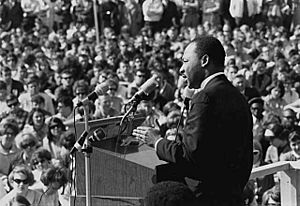
- On April 15, 1967, a massive anti-war demonstration took place in New York City. Over 400,000 people marched from Central Park to the United Nations. Speakers included Martin Luther King Jr. and Harry Belafonte.
- The Vietnam Veterans Against the War (VVAW) was formed in June 1967. This group was made up of soldiers who had served in Vietnam and then protested the war.
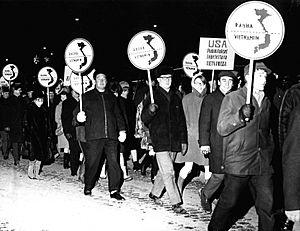
- In October 1967, a protest at the University of Wisconsin–Madison turned violent. Students protested Dow Chemical, a company that made napalm, a chemical used in the war.
- The March on the Pentagon in October 1967 brought 100,000 people to the Lincoln Memorial. Many then marched to the Pentagon to protest.
1968: A Year of Upheaval
- In January 1968, singer Eartha Kitt spoke out against the war at a White House luncheon. She talked about how the war affected young people.
- The assassination of Martin Luther King Jr. in April 1968 silenced a major anti-war leader.
- In August 1968, the Democratic National Convention in Chicago saw major protests. There were clashes between protesters and police, with people chanting, "The whole world is watching."
Later Protests and Key Events
- Throughout 1969, campus protests continued across the country.
- The Moratorium to End the War in Vietnam in October 1969 brought huge crowds to Washington, D.C. and Boston. Another large march in November 1969 gathered 500,000 people in Washington, D.C.
- In 1970, the Kent State Shootings occurred. U.S. National Guard members killed four young people during a protest at Kent State University. This event led to four million students going on strike at hundreds of colleges.
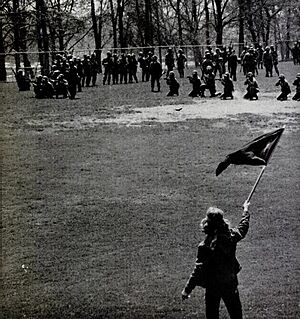
- The Hard Hat Riot in New York City in May 1970 saw pro-war construction workers attack anti-war students.
- In August 1970, the Chicano Moratorium in Los Angeles was the largest anti-war protest by Mexican-Americans.
- In April 1971, a peaceful "Vietnam War Out Now" rally in Washington, D.C. had over half a million participants.
- The 1971 May Day Protests in Washington, D.C., led to over 12,000 arrests. This was the most people ever arrested at a single event in American history.
- In July 1972, actress Jane Fonda visited North Vietnam and spoke on Hanoi Radio, which caused controversy.
- In August 1972, Vietnam veteran Ron Kovic, who used a wheelchair, protested at the 1972 Republican National Convention. He shouted, "Stop the bombing! Stop the war!"
Common Slogans and Chants
During the Vietnam War, people used many slogans to express their views. Those against the war were called "doves," and those who supported it were called "hawks."
Anti-war Slogans
- "Hey, hey, LBJ, how many kids did you kill today?" This was a common chant aimed at President Lyndon B. Johnson.
Pro-war Slogans
- "Love our country"
- "America, love it or leave it"
- "No glory like old glory"
Images for kids
-
Protest against the Vietnam War in Amsterdam in April 1968
-
Martin Luther King Jr. speaking to an anti-Vietnam war rally at the University of Minnesota in Saint Paul, Minnesota, on April 27, 1967
-
A protest against the Vietnam War in Helsinki in December 1967
-
West German students protest against the Vietnam War in 1968
-
A student protests before the Ohio National Guard at Kent State University shortly before the Kent State Shootings. May 4, 1970.
See also
- Anti-nuclear protests in the United States
- List of songs about the Vietnam War
- Opposition to United States involvement in the Vietnam War
- Timeline of 1960s counterculture


